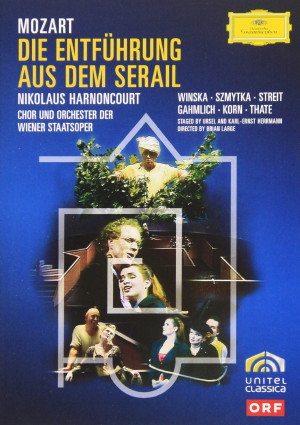 |
2 DVD
- 00440
073 4540 - (c) 2009
|
|
Wolfgang Amadeus
Mozart (1756-1791)
|
|
|
|
|
|
| Die Entführung
aus dem Serail, KV 384 |
|
|
| Singspiel in
drei Akten - Libretto
Gottlieb Stephanie der Jüngere
(after Christoph Friedrich Bretzner) |
|
|
|
|
|
| Opening |
1' 48" |
|
| - Ouvertüre |
4' 00" |
|
| - Erster Aufzug |
49' 29" |
|
| - Zweiter Aufzug
|
82' 10" |
|
|
|
|
- Dritter Aufzug
|
61' 03" |
|
|
|
|
Hilmar
Thate, Selim
|
Ursel
& Karl-Ernst Herrmann, stage
director |
|
Kurt
Streit, Belmonte
|
Karl-Ernst
Herrmann, set & costume
design |
|
Aga
Winska, Konstanze
|
Brian
Large, video director |
|
| Elzbieta
Szmytka, Blonde |
|
|
| Wilfried
Gahmlich, Pedrillo |
|
|
| Artur
Korn, Osmin |
|
|
| Christian
Metternich, Klaas |
|
|
| Walter
Bartussek, Ein Stummer |
|
|
|
|
Chorsolisten: Ingrid Sieghart
/ Elisabeth Mach / Adolf Tomaschek / Josef
Stangl
|
|
| Chor der Wiener Staatsoper /
Karl Kamper, Chorus Master |
|
| Buhnenorchester der
Osterreichischen Bundestheater / Ralf
Hossfeld, Conductor |
|
Orchester der Wiener Staatsoper
|
|
|
|
| Nikolaus
Harnoncourt, Conductor |
|
|
Luogo e data
di registrazione
|
| Theater
an der Wien, Vienna (Austria) -
maggio 1989 |
|
Registrazione
live / studio
|
| live |
Producer / Engineer
|
Co-production of Wiener
Festwochen, Wiener Staatsoper and Opéra
National, Théâtre Royal de la Monnais,
Brussels
|
Edizione DVD
|
| Deutsche Grammophon - 00440
073 4540 - (2 dvd) - 136' 00" + 62'
00" - (c) 2009 - ORF/Unitel (c)
1989 - (DE) GB-DE-SP-CH |
|
| Note |
AN
ENLIGHTENING ENTFÜHRUNG
FROM VIENNA
Mozart's
first great German opera, Die Entführung
aus dem Serail (The Abduction from
the Seraglio), the piece that made the
composer's reputation with Viennese
audiences at the beginning of the 1780s
and which remained the most popular of
his stage works during his short
lifetime, throws down a host of
challenges to modern sensibilities. Its
themes of captivity, justice,
retribution and forgiveness never become
outdated, and neither, sadly, does the
backdrop against which the drama is
played out, that of cultural conflict
and misunderstanding. This is a work -
Mozart's contribution to a project to
establish opera in German in a cultural
milieu where Italian opera was the norm
- that overflows with music in a way
that can easily swamp the dialogue, as
Emperor Joseph II is
reputed to have spotted at the very
outset ("Too many notes, my dear
Mozart").
When the husband and wife team
Karl-Ernst and Ursel Herrmann created
this production for the Vienna Festival
in 1989, they redressed the balance, not
only focusing on the dialogue and, just
as importantly, on wordless action as
well, but also putting a prowling, tense
and unhappy Selim, Hilmar Thate, a
former member of the legendary Berliner
Ensemble, at the very centre of the
drama. For all the comedic aspects of
the Pasha's household, represented by
the buffoonish Osmin, the resentment and
defensiveness that this speaking
character conveys has a powerto match
the depth of feeling that Mozait gives
to the singing roles. And, strikingly,
the emotional content of the orchestral
introduction to Constanze's aria
"Martern aller Arten" is identified as
much with the captor as with the
captive.
After his groundbreaking cycle of
Monteverdi operas at the Zurich Opera
House, Nikolaus Harnoncourt began to
explore the Mozart operas there in 1980,
before being invited to Vienna, where he
conducted Idomeneo
and Die Zauberflöte at the State
Opera, followed by this Entfürung
at the Theater an der Wien. The springy
rhythms of the young Mozart’s
"Turkish" style, with their exotic
percussion accompaniment - here taken
out of the pit and paraded on stage -
are a gift to the conductor’s
historically informed approach, but
equally telling is the rhythmic fluidity
of Constanze's great tragic arias,
"Traurigkeit" and "Ach, ich liebte".
These last words, ”Oh, I was
in love", are the very ones that,
intriguingly, Mozart's own Constanze
copied out on the back of a letter the
composer sent to his father in September
1781 to give him some examples of the
music he was writing.
A largely young cast is headed by Kurt
Streit, who has made a speciality of
Mozart's demanding tenor roles, from Idomeneo
to Tito. The character of
Belmonte is seen here as an
Enlightenment figure, a seeker about to
encounter some difficult truths when he
is reunited with his beloved Constanze,
played by the Polish soprano Aga Winska.
After appearing in Mozart (Le nozze
di Figaro)
and Verdi (Rigoletto)
in Warsaw and Cracow, the young soprano
was making her Vienna début
in this role. Fellow Pole Elzbieta
Szmytka, as her English maid Blonde,
later graduated to the role of
Constanze, while Wilfried Gahmlich had
sung the role of Pedrillo in
Harnoncourt's 1985 recording of the
opera, and the tragic-comic role of
Osmin is a staple of German bass Artur
Korn's repertoire.
Drawing the whole together is
Harnoncourt's responsive and
dramatically driven musical direction.
Kurt Streit has spoken admiringly of the
conductor’s work with singers: "He has
the gift of being able to bring out the
best in you. He goes with the flow, yet
he always has something to say." And the
great quartet of discovery, doubt and
reconciliation that bringsthe second act
to a close proves the point: maintaining
the essential clarity of texture,
Harnoncourt charts a finely gauged
sequence of tempos to convey the four
characters' shifting feelings.
|
|
Nikolaus
Harnoncourt (1929-2016)
|

|

|
|